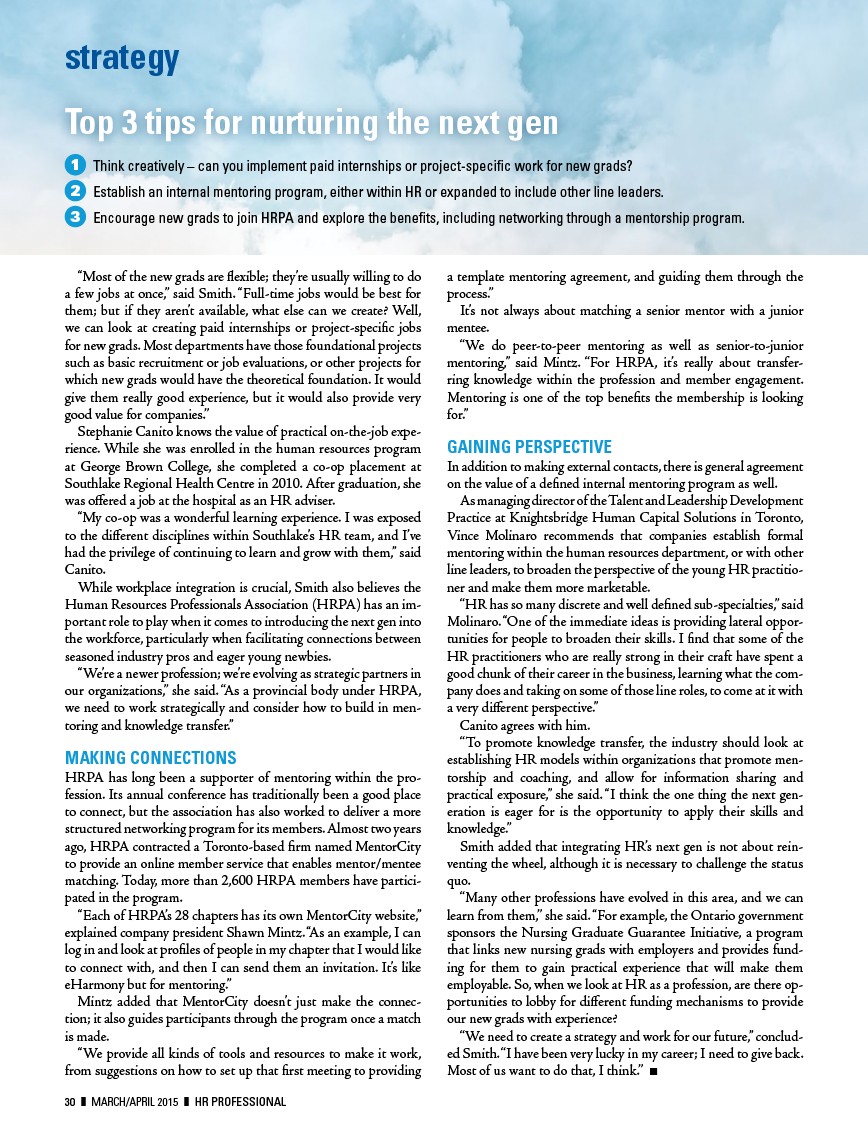
strategy
Top 3 tips for nurturing the next gen
1 Think creatively – can you implement paid internships or project-specific work for new grads?
2 Establish an internal mentoring program, either within HR or expanded to include other line leaders.
3 Encourage new grads to join HRPA and explore the benefits, including networking through a mentorship program.
“Most of the new grads are flexible; they’re usually willing to do
a few jobs at once,” said Smith. “Full-time jobs would be best for
them; but if they aren’t available, what else can we create? Well,
we can look at creating paid internships or project-specific jobs
for new grads. Most departments have those foundational projects
such as basic recruitment or job evaluations, or other projects for
which new grads would have the theoretical foundation. It would
give them really good experience, but it would also provide very
good value for companies.”
Stephanie Canito knows the value of practical on-the-job experience.
While she was enrolled in the human resources program
at George Brown College, she completed a co-op placement at
Southlake Regional Health Centre in 2010. After graduation, she
was offered a job at the hospital as an HR adviser.
“My co-op was a wonderful learning experience. I was exposed
to the different disciplines within Southlake’s HR team, and I’ve
had the privilege of continuing to learn and grow with them,” said
Canito.
While workplace integration is crucial, Smith also believes the
Human Resources Professionals Association (HRPA) has an important
role to play when it comes to introducing the next gen into
the workforce, particularly when facilitating connections between
seasoned industry pros and eager young newbies.
“We’re a newer profession; we’re evolving as strategic partners in
our organizations,” she said. “As a provincial body under HRPA,
we need to work strategically and consider how to build in mentoring
and knowledge transfer.”
MAKING CONNECTIONS
HRPA has long been a supporter of mentoring within the profession.
Its annual conference has traditionally been a good place
to connect, but the association has also worked to deliver a more
structured networking program for its members. Almost two years
ago, HRPA contracted a Toronto-based firm named MentorCity
to provide an online member service that enables mentor/mentee
matching. Today, more than 2,600 HRPA members have participated
in the program.
“Each of HRPA’s 28 chapters has its own MentorCity website,”
explained company president Shawn Mintz. “As an example, I can
log in and look at profiles of people in my chapter that I would like
to connect with, and then I can send them an invitation. It’s like
eHarmony but for mentoring.”
Mintz added that MentorCity doesn’t just make the connection;
it also guides participants through the program once a match
is made.
“We provide all kinds of tools and resources to make it work,
from suggestions on how to set up that first meeting to providing
a template mentoring agreement, and guiding them through the
process.”
It’s not always about matching a senior mentor with a junior
mentee.
“We do peer-to-peer mentoring as well as senior-to-junior
mentoring,” said Mintz. “For HRPA, it’s really about transferring
knowledge within the profession and member engagement.
Mentoring is one of the top benefits the membership is looking
for.”
GAINING PERSPECTIVE
In addition to making external contacts, there is general agreement
on the value of a defined internal mentoring program as well.
As managing director of the Talent and Leadership Development
Practice at Knightsbridge Human Capital Solutions in Toronto,
Vince Molinaro recommends that companies establish formal
mentoring within the human resources department, or with other
line leaders, to broaden the perspective of the young HR practitioner
and make them more marketable.
“HR has so many discrete and well defined sub-specialties,” said
Molinaro. “One of the immediate ideas is providing lateral opportunities
for people to broaden their skills. I find that some of the
HR practitioners who are really strong in their craft have spent a
good chunk of their career in the business, learning what the company
does and taking on some of those line roles, to come at it with
a very different perspective.”
Canito agrees with him.
“To promote knowledge transfer, the industry should look at
establishing HR models within organizations that promote mentorship
and coaching, and allow for information sharing and
practical exposure,” she said. “I think the one thing the next generation
is eager for is the opportunity to apply their skills and
knowledge.”
Smith added that integrating HR’s next gen is not about reinventing
the wheel, although it is necessary to challenge the status
quo.
“Many other professions have evolved in this area, and we can
learn from them,” she said. “For example, the Ontario government
sponsors the Nursing Graduate Guarantee Initiative, a program
that links new nursing grads with employers and provides funding
for them to gain practical experience that will make them
employable. So, when we look at HR as a profession, are there opportunities
to lobby for different funding mechanisms to provide
our new grads with experience?
“We need to create a strategy and work for our future,” concluded
Smith. “I have been very lucky in my career; I need to give back.
Most of us want to do that, I think.” ■
30 ❚ MARCH/APRIL 2015 ❚ HR PROFESSIONAL